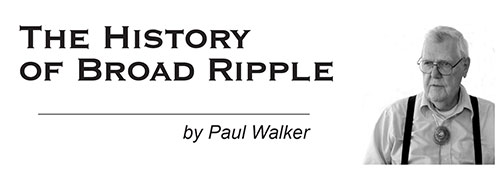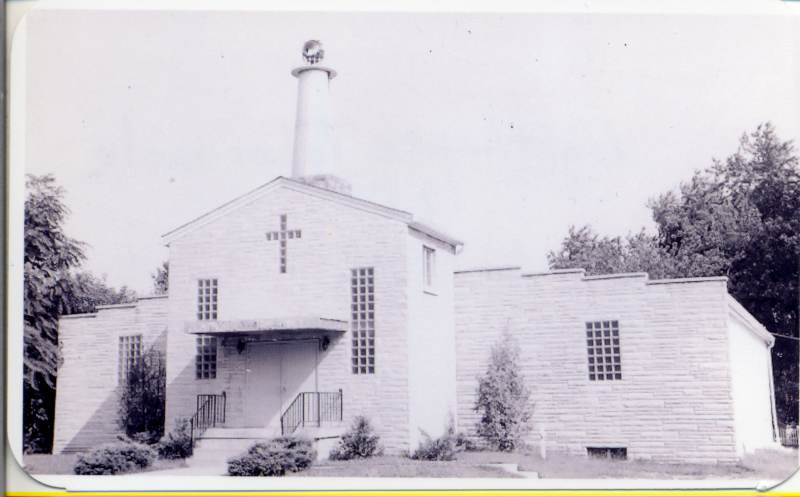
|
Broad Ripple Random Ripplings

The news from Broad Ripple
Brought to you by The Broad Ripple Gazette
(Delivering the news since 2004, every two weeks)

|
| Brought to you by: |

|

|

|

|

|

|
Converted from paper version of the Broad Ripple Gazette (v03n10)
The History of Broad Ripple: Families of Old Broad Ripple: The Featherstons - part three - by Paul Walker
posted: May 19, 2006

Denzil and Bill Totman began to regularly attend Cadle Tabernacle where the most outstanding preachers in the USA could be heard. Both young people became dedicated Christians there. It was there that she experienced a revelation that she was going to be a minister or evangelist.
Cadle Tabernacle was a very famous structure in Indianapolis, and was known all over the country. A huge, one-storied stuccoed auditorium, it held over a thousand people and filled the block bounded by New Jersey, Ohio, Delaware, and New York Streets. Boxing matches were held there as well as Klan rallies. High schools used it for graduations, including mine from Shortridge in 1939. It was demolished in the mid 60's.
The Totmans had plans for a plot of ground on which to build a church. On 66th Street was, probably, the most miserable half acre in Broad Ripple when I went into the service. Behind our house on Ferguson Street would have been an alley if the one between Ferguson and Bellefontaine continued north of 66th Street. What was left was a path that led to the last house to the north, where the Hinshaws lived. Perry Hinshaw was a motorman on the interurban line, as was the father of the future fire chief, Bill Earle.
Years later when I moved back to Indianapolis from California, I found a beautiful stone church in this area. I was long out of touch with the Featherstons, but learned that Denzil and her husband Bill had built the Lighthouse Tabernacle. The plot of ground was no longer God-forsaken.
Lighthouse Tabernacle (on 66th Street) in 1956

image courtesy of Denzil Featherston
Asked how they had financed the church, she stated that her mother had a little money which, with their earnings and God's help, they got it built. The only trouble they encountered was a minor one: The neighbor lady, who was anti-church and anti-everything, threw trash and garbage onto the church property. I was aware that this same lady made life miserable for a young married couple on the other side of her house. This brought the young bride to tears much of the time.
Denzil related that on the day the cement trucks were on the way to pour the foundations, it threatened rain, whereupon she and Bill commenced to pray. The clouds went away and the cement was poured.
The church was so successful, that the Totmans built a large church at 98th Street and Keystone where it prospers today. They had two children, Barbara and David. Barbara is an extremely successful real estate agent, and David is pastor of the Lighthouse Tabernacle. Bill Totman has passed away.
The Totmans are well known and highly regarded by old-timers in the Assemblies of God. They were involved in the early expansion of this denomination and the subsequent Charismatic Renewal.
Grandpa's 1913 Maxwell sat behind our house in the alley. A huge car, with wheels as tall as a 6-year old child, it sported a bulb horn and carbide headlights. It was a right hand drive vehicle, and a fun place for kids to play. My brother Tom reportedly drove it sixty miles per hour. Dad sold it for junk to aid the war effort, since it was all aluminum and brass. It would be worth $300,000 today in the same condition as then.
The above plot of ground behind our house and the alley extended east to Bellefontaine Street, a one-lane gravel trail running along the Monon tracks north over the levee into the "camps" [where the Indianapolis Art Center now is]. To the north of the lot was another half acre, heavily wooded, where men trapped fur-bearing animals and hunted rabbits and squirrels for food with rifles. (Shotguns were not used as they tore up any game sought for augmenting the grocery bill.) No one worried about firing guns in the city limits, nor did they know if there was such an ordinance. The area around the pond was good for trapping, likewise. Earl Augustine and others skinned what they trapped, and I remember seeing the skins turned inside out stretched on specially shaped boards to cure. Furriers would buy the cured furs.
The pond was a popular fishing spot. In a previous article I reported being with Herbert Hoover when he set the dumps on fire. It burned over a week from the methane gas coming out of the garbage.
In the middle of this God-forsaken plot was a weathered, neglected, gnarled, old apple tree, the apples of which were not worth picking. In one corner of this area Herbert Hoover and I dug a cave and found that under two feet of dirt lay pure, deep sand. We tunneled back under the dirt bank, which, if it had caved in, would have eliminated the young Mr. Hoover and Mr. Walker.
The End.
info@broadripplegazette.com

|

|

|
| Brought to you by: |

|

|

|
| Brought to you by: |

|

|

|


